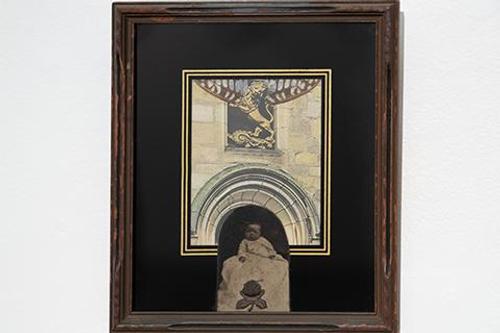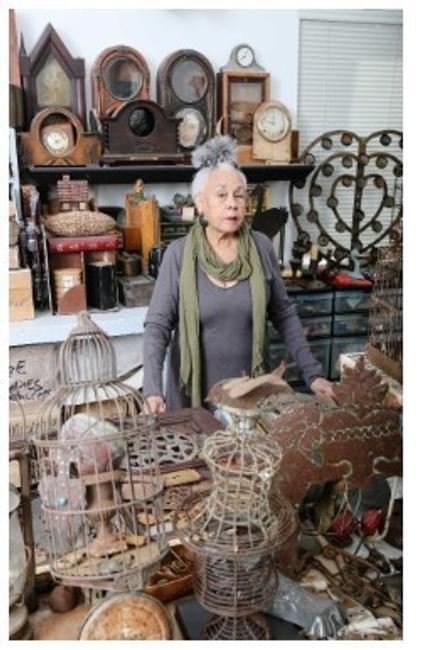Cal State LA Exhibition Highlights Renowned Los Angeles Artist Betye Saar
Nearly half a century after Cal State LA hosted renowned Los Angeles artist Betye Saar’s first solo show, the work of the iconic assemblage artist has returned to the university as part of a new art exhibition.

Saar, 94, is known for her celebrated assemblage works—stirring collections and collages of materials and recycled everyday objects that explore themes of race, gender, family and mysticism.
Her first solo survey exhibition was displayed at Cal State LA in 1973. Betye Saar: Selected Works 1964-1973 included pieces that reclaimed derogatory Black memorabilia and explored spirituality.
In the five decades since, Saar’s poignant pieces conveying the personal, political and historical have inspired the work of generations of artists.
Mojo Rising, a new exhibition at the Ronald H. Silverman Fine Arts Gallery at Cal State LA, honors Saar and her immense influence. The gallery is part of the College of Arts and Letters.
The exhibition, curated by jill moniz, includes 40 pieces by Saar and 29 other artists. Viewers can explore the artwork virtually through the gallery’s video tour.
“This exhibition brings together many different voices that Betye Saar has helped make space to hear in Los Angeles and beyond,” said moniz, who considers Saar a mentor, colleague and friend.

In curating the exhibition, moniz aimed to highlight the influence of Saar’s work and ongoing practice, selecting pieces by artists who know Saar personally or who she taught or mentored.
Featured artists include Betye Saar’s daughters Alison and Lezley Saar, her granddaughter Maddy Inez Leeser, her former students from the Otis College of Art and Design Kerry James Marshall and Sarah Perry, and Saar’s Black Arts West movement contemporaries Nathaniel Bustion, David Hammons and John Outterbridge.
“There’s something very old, and something very new at the same time about what she does. When you know Betye, and you start to really look into her work, you start to think that she escaped from one of the pyramids or something,” Outterbridge said in a retrospective article published in 2019 by Brooklyn-based online arts publication Hyperallergic, which was quoting from the 1977 documentary film Spirit Catcher: The Art of Betye Saar. “She’s just into a strong mystical quality, and somehow I think that she was a daughter to one of the pharaohs or something.”
The works displayed in Mojo Rising include provocative mixed media collages, sculptures and installations made of wood, fabrics, newsprint, cement and other materials, as well as charcoal and ink prints, with commentary on topics of race, religion and spirituality, history and more.
Saar’s artwork combines symbols, objects and materials found in Los Angeles and through her travels around the world. Born in 1926 in the Watts neighborhood of Los Angeles and raised in Pasadena, Saar is a printmaker and visual storyteller.
Saar was a prominent figure in the Black Arts movement of the 1960s and 1970s. The Black Arts movement celebrated Black artists and intellectuals in the fields of music, literature, drama and visual arts, and was considered to be the cultural arm of the Black Power movement.
The New York Times called Saar “one of the country’s most inventive and influential makers of intimately scaled assemblage.” An article in the Los Angeles Times dubbed her “a key player in myriad artist movements” from the Black Arts movement, to feminist art and assemblage.
Saar is a prolific artist, with hundreds of works that have been displayed in more than 80 solo shows at galleries and museums in the U.S. and internationally. In 2019, Saar opened two solo shows at the Museum of Modern Art (MoMA) in New York and the Los Angeles County Museum of Art (LACMA).
“During her long career, Betye Saar has confronted, not only issues of race and class, but also the marginalization suffered by female artists,” said Mika Cho, director for the Ronald H. Silverman Fine Arts Gallery. “The person of Betye Saar is legendary as a great storyteller, but also as a Black woman who has enormously influenced many American artists. My aim was to present her work and to celebrate her genius.”
Mojo Rising also displays works by Tanya Aguiñiga, Kelly Berg, Lavialle Campbell, Kendall Carter, Carolina Caycedo, Chelsea Dean, Keiko Fukazawa, Yrneh Gabon, Todd Gray, Regina Herod, Gronk, Lilah Lutes, Rodney McMillian, Rosalyn Myles, Minoru and Echiko Ohira, Duane Paul, Emma Robbins, Kenzi Shiokava, Cola Smith, Lisa Diane Wedgeworth, Monica Wyatt and Brenna Youngblood.
“Betye Saar is to assemblage what Mick Jagger is to rock and roll,” Wyatt told Fabrik magazine.









